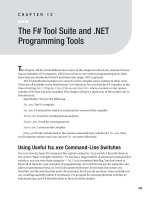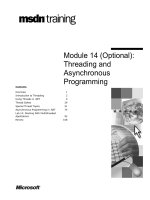Jeff nippard upper lower strength and size program
Bạn đang xem bản rút gọn của tài liệu. Xem và tải ngay bản đầy đủ của tài liệu tại đây (9.22 MB, 87 trang )
UPPER
LOWER
JEFF NIPPARD’S
SIZE AND STRENGTH PROGRAM
UPPER
LOWER
JEFF NIPPARD’S
SIZE AND STRENGTH PROGRAM
DISCLAIMER
All documents included or exchanged between Jeff Nippard and the Client are
the intellectual property of STRCNG Incorporated and are not to be copied, sold,
published, posted, or redistributed either in part or in full without my written
consent. All violations will be prosecuted to the fullest extent of the law.
Jeff Nippard is not a doctor or registered dietitian. The contents of this document
should not be taken as medical advice. It is not intended to diagnose, treat, cure, or
prevent any health problem - nor is it intended to replace the advice of a physician.
Always consult your physician or qualified health professional on any matters
regarding your health. Use of the information in this program is strictly at your own
risk. Jeff Nippard and/or STRCNG Incorporated will not assume any liability for any
direct or indirect losses or damages that may result including, but not limited to,
economic loss, injury, illness or death.
JEFF NIPPARD’S - UPPER/LOWER SIZE AND STRENGTH PROGRAM
3
COMMENTS FROM JEFF
For customer support please email As much as I love connecting
on social media, I am not able to reliably respond to the questions I receive across
platforms so please direct any questions to the email above. Please allow 3-5
business days for an email reply.
Thank you so much for your support and good luck with the training!
JEFF NIPPARD’S - UPPER/LOWER SIZE AND STRENGTH PROGRAM
4
TABLE OF CONTENTS
DISCLAIMER
3
ABOUT ME
6
KEY TERMS
8
ABOUT THIS PROGRAM
ANATOMY
10
FREQUENTLY ASKED QUESTIONS
WARM UP
13
24
29
UPPER/LOWER SIZE AND STRENGTH PROGRAM
WEAK POINT EXERCISES TABLE
32
59
PROGRAM EXPLAINED
60
TRAINING VARIABLES
68
EXERCISE SUBSTITUTIONS
74
EXERCISE VIDEOS
79
REFERENCES
84
ABOUT ME
Jeff is a professional drug-free bodybuilder and powerlifter. Through his informative
and entertaining Youtube channel which has gathered a fan-base of over 1 million
subscribers, Jeff aims to share the knowledge he has gathered through university
education and field experience with others who are passionate about the science
behind building muscle, losing fat and getting healthier.
He earned the title of Mr. Junior Canada for natural bodybuilding in 2012 and as a
powerlifter, Jeff held the Canadian national record for the bench press in 2014. As a
powerlifter, Jeff has claimed a 502 lb squat, 336 lb bench press and a 518 lb deadlift
with an all time best Wilks score of 446.
With a Bachelor of Science degree in biochemistry, Jeff has gathered the requisite
scientific knowledge to compliment his practical experience acquired through
JEFF NIPPARD’S - UPPER/LOWER SIZE AND STRENGTH PROGRAM
6
training and coaching. Jeff has coached women’s bikini and men’s bodybuilding
national and provincial champions, professional natural bodybuilders and nationally
and IPF Worlds qualified raw powerlifters. He has presented seminars on Block
Periodization, concurrent training and nutrition and training for natural bodybuilding
in academic settings including the 2014 Online Fitness Summit, Lehman College and
the University of Iowa. He has aspirations of completing a PhD in exercise science or
a related field.
Jeff currently lives in Kelowna, Canada where he is producing informative YouTube
videos and podcasts .
JEFF NIPPARD’S - UPPER/LOWER SIZE AND STRENGTH PROGRAM
7
KEY TERMS
DB: Dumbbell
LSRPE: Last set RPE
PROGRESSIVE OVERLOAD: The gradual increase of stress placed upon
the body during exercise training. In training contexts, this generally involves
progressively increasing some lifting parameter over time (usually weight or reps)
ROM: Range of motion
RPE: Rate of perceived exertion. A measure of how difficult a set was on a 1-10
scale, with 10 meaning muscular failure was achieved.
TEMPO: The speed at which the lift occurs.
ECCENTRIC: The lowering (“negative”) aspect of the lift
CONCENTRIC: The contracting (“positive”) aspect of the lift
EFFORT: How hard you are pushing the set relative to failure. Measured with RPE or
%1RM
JEFF NIPPARD’S - UPPER/LOWER SIZE AND STRENGTH PROGRAM
8
LOAD: The weight of the external resistance
INTENSITY: Effort and load
VOLUME: Total amount of work performed. Usually approximated as sets x reps x
load
FREQUENCY: How often you directly train a given muscle per 7 days
HYPERTROPHY: The growth of (muscle) tissue
AMRAP: As many reps as possible (with good form). Often performed as a test to
determine max strength
PRIMARY EXERCISE: Main heavy compound movements that involve a large
muscle mass (For Example: squats, bench presses and deadlifts)
SECONDARY EXERCISE: Compound exercises which involve less muscle mass
(For Example: cable rows, lunges, hip thrusts, military presses, pull-ups, etc.)
TERTIARY EXERCISE: Isolation movements involving only one joint and primarily
targeting a single muscle – these are usually used to isolate a specific, smaller muscle
or to generate metabolic stress
PERIODIZATION: The organization of training over time
JEFF NIPPARD’S - UPPER/LOWER SIZE AND STRENGTH PROGRAM
9
ABOUT THIS PROGRAM
WHAT THIS PROGRAM IS
The primary goal of this program is to maximize muscle hypertrophy and strength
development for individuals in the intermediate-advanced stage of training
advancement. The secondary goal of this program is to introduce more advanced
and specialized intensity techniques to recruit a larger spectrum of muscle fibers
and focus on weak point development. It’s difficult to pin down exactly what
“intermediate-advanced” means in terms of a specific training age due to the fact
that training years in the gym are not equal across individuals. For example, some
folks may have spent 10 years training in the gym, but that time may only actually be
“worth” 1 or 2 years if they’ve spent the majority of their time pumping and going
through the motions without focus or direction. But as a general guide, if you’ve
been training for roughly 2-5 years, with a generally serious approach toward your
training sessions, you will benefit from this program. If you’ve been training without
JEFF NIPPARD’S - UPPER/LOWER SIZE AND STRENGTH PROGRAM
10
adequate structure for even a few months, it doesn’t matter how long you’ve been in
the gym, this program will get you on the right track.
This program is intended to build on my Push Pull Legs Hypertrophy Program but
you can still run this program without having run the PPL program first. You can also
run these in “reverse order” where you run the upper/lower program first and then
run the PPL program after.
Before we dive into the nuts and bolts of the program itself, I want to first make it
clear what this training manual is intended to accomplish. As I’ll allude to throughout
the document, this program is only comprised of a single training block lasting 9
weeks. Because wave-loading is used as the main progression model, there is no
formal deload included, however, fatigue will be managed by “waving” efforts in the
gym (where Weeks 1, 4 and 7 serve as “mini-deload weeks”). We will be using three
separate 3-week waves: Week 1 will feel relatively easy, Week 2 will be a bit harder
and Week 3 will be quite challenging. Then in Week 4, efforts will be lower again
and we will build back up from there over the next 3 weeks. This is what is meant by
“waving”.
As you get more and more advanced, progress becomes more and more difficult to
achieve. To break through sticking points in progression, this routine focuses heavily
on training variables like advanced intensity techniques, specific form cues, mindmuscle connection and recovery management.
WHAT THIS PROGRAM ISN’T
If you’ve been in the gym for less than 2 years, I’d recommend running through my
Fundamentals Program at least once before advancing to this routine to ensure
JEFF NIPPARD’S - UPPER/LOWER SIZE AND STRENGTH PROGRAM
11
that you have already established an adequate strength and technique base before
running this high frequency program.
This program is not intended to be an all-inclusive resource for all things training
related. I initially wrote this document as a supplemental resource to my Science
Applied YouTube Series and my Fundamentals YouTube Series, meaning that there
will be information covered in the series that won’t be recapitulated here.
With that said, there is still plenty to chew on here: just about 80 pages in total,
including a full blown anatomy section (something I didn’t have the chance to cover
in a single YouTube Series in detail), a section explaining the specific programming
principles at play (volume, intensity, frequency, etc.), video links for technique
demonstration for each exercise and over 30 scientific references.
JEFF NIPPARD’S - UPPER/LOWER SIZE AND STRENGTH PROGRAM
12
FUNCTIONAL ANATOMY
It’s important to understand the functional anatomy and biomechanics of the
main muscles we’ll be targeting before we can understand how to best train them.
Functional anatomy determines what muscles can do. There are two things to
consider when looking at a muscle’s functional anatomy – origin and insertion.
Muscles attach to bone by tendons from at least two points. The origin is the fixed
attachment which does not move and the insertion is the attachment which moves
closer to the origin when a muscle contracts. This contracting phase, referred to as
the concentric phase (known as the “positive” phase), is normally followed by the
eccentric phase (lowering the weight – also known as the “negative” phase).
JEFF NIPPARD’S - UPPER/LOWER SIZE AND STRENGTH PROGRAM
13
Figure 1A: The Main Posterior Muscles
Figure 1B: The Main Anterior Muscles
Figure 2: Quadriceps Anatomy
QUADRICEPS: The quadriceps (“quads” for short) are
comprised of four muscles, often referred to as “heads”: the
vastus lateralis (“quad sweep”), vastus medialis (“tear drop”),
rectus femoris (the middle portion of your upper thigh), and
vastus intermedius (which runs underneath rectus femoris).
The quads act to extend the knee, taking the leg from a
bent position to a straight position. Each muscle of the quad
has its own unique insertion which we won’t worry about
too much here. Just remember that the main action of the
quads is to extend (straighten) the knee.
ORIGIN: The vasti muscles originate on the body of femur
(“thigh bone”). The rectus femoris originates on the illium of
the “hip bone”
INSERTION: Tibial tuberosity
EXERCISES: Back squat, leg press, front squat, leg extension, dumbbell walking
lunge, Bulgarian split squat, knee-banded leg press, dumbbell step-up
JEFF NIPPARD’S - UPPER/LOWER SIZE AND STRENGTH PROGRAM
14
HAMSTRINGS: The hamstrings are
actually a complex of four muscles:
semimembranosus, semitendinosus, and
biceps femoris (which consists of a long
head and a short head). The hamstrings
collectively act to both flex the knee (take
the leg from a straightened position to a
bent position, as in a leg curl) and extend
the hip (pushing your hips forward, as in a
deadlift).
ORIGIN: The semitendinosus,
semimembranosus, and long head of the
biceps femoris originate on the ischial
tuberosity. The short head of the biceps
femoris originates on the linea aspera.
INSERTION: The semitendinosus and
semimembranosus both insert on the tibia,
while both the long and short heads of the
biceps femoris insert at the fibula.
EXERCISES: Stiff leg deadlift, good
morning, deadlift, lying leg curl, seated leg
curl, cable pull-through, deficit deadlift,
barbell 45° hyperextension, sliding leg curl,
Figure 3: Hamstrings Anatomy
reverse hyper
GLUTEALS: The gluteals (or “glutes”) are also a complex of muscles consisting of the
gluteus maximus, gluteus medius, and gluteus minimus. As the name suggests, the
JEFF NIPPARD’S - UPPER/LOWER SIZE AND STRENGTH PROGRAM
15
gluteus maximus is the largest of the three, followed by the gluteus medius, and the
smallest gluteus minimus. The gluteus maximus has multiple origins including the
pelvis, sacrum, coccyx, and thoracolumbar fascia and multiple insertions including
the upper femur and IT band. Because of this, it is able to perform a wide variety of
functions, but primarily:
- Hip extension (push your hips forward)
- Hip abduction (move your thigh away from the midline)
- Hip external rotation (rotating your thigh bone outwards)
- Posterior pelvic tilt (tucking your butt “in”)
The smaller glute medius still occupies a hefty portion of the rear hip musculature
and functions primarily as a stabilizer during dynamic movement and as a hip
abductor. It originates on the pelvis and inserts on the femur. It is most effectively
trained with exercises that require a high degree of stability, especially unilateral
movements such as walking lunges, and exercises that train hip abduction, such as
machine hip abductions.
ORIGIN: The gluteus maximus, medius, and minimus originate on the ilium.
INSERTION: The gluteus maximus and gluteus minimus insert to the iliotibial tract (IT
band) and the gluteal tuberosity on the femur. The gluteus
medius inserts to the greater trochanter on the femur.
EXERCISES: Back squat, stiff leg deadlift, good morning,
deadlift, front squat, barbell hip thrust, dumbbell walking
lunge, cable pull-through, machine hip abduction, deficit
deadlift, Bulgarian split squat, barbell 45° hyperextension,
knee-banded leg press, dumbbell step-up, reverse hyper,
cable standing hip abduction
Figure 4: Gluteals Anatomy
JEFF NIPPARD’S - UPPER/LOWER SIZE AND STRENGTH PROGRAM
16
PECTORALIS: There are
two pectoralis muscles
(pecs for short) located on
your chest: the pectoralis
major and the pectoralis
minor. The pectoralis
major can be divided into
two heads: the clavicular
head or “upper chest”
(which originates at the
clavicle) and the sternal
head or “lower chest”
(which originates at the
sternum). The pecs act
Figure 5: Pectoral Anatomy
to adduct the upper arm
(bring the upper arm across the body), and to internally rotate the shoulder joint.
The clavicular fibers also aid in shoulder flexion (raising your upper arm up), but the
sternal fibers do not.
ORIGIN: The pectoralis major originates on the sternum and clavicle. The pectoralis
minor originates on the 3rd-5th ribs.
INSERTION: The pectoralis major inserts on the humerus. The pectoralis minor
inserts to the coracoid process (front of your shoulder).
EXERCISES: Barbell bench press, pause dumbbell incline press, barbell close-grip
bench press, cable flye 21s, barbell incline press, dip, machine chest press, barbell
floor press, push-up, California press.
JEFF NIPPARD’S - UPPER/LOWER SIZE AND STRENGTH PROGRAM
17
BACK: The back is
comprised of a massive web
of muscles, so for the sake of
simplicity we will only look
at the largest back muscles.
The latissimus dorsi (lats for
short) is a big muscle which
runs from just underneath
your arm pit all the way
down to the bottom of your
back. The lats primarily act to
extend the shoulder (bring
your upper arm downward)
and adduct the shoulder
(moving your elbows
towards your mid back).
The trapezius (traps for
short), is another large
muscle running from the
base of the skull down to the
middle of your inner back.
When people think about
the traps, they tend to only
Figure 6: Latissimus Dorsi Anatomy
think of the upper fibers, but the middle and lower fibers take up a very large surface
area as well. The traps act to elevate the scapulae (shrugging your shoulders), retract
the scapulae (pull the shoulder blades back), and extend the shoulder (pull your
arms backward when your elbows are raised).
JEFF NIPPARD’S - UPPER/LOWER SIZE AND STRENGTH PROGRAM
18
LATS:
ORIGIN: : Illiac crest and
thoracolumnar fascia
INSERTION: Humerus
EXERCISES: Lat pulldown, Pendlay
row/bent over row, wide-grip pullup, cable close grip row, machine
chest-supported row w/ band,
seated T-bar row, neutral-grip pullup, eccentric-accentuated cable
row, banded chest-supported row,
barbell supinated row, supinated lat
pulldown, machine high row, barbell
bent over row
TRAPS:
ORIGIN: Occipital bone (upper
traps), corresponding supraspinous
ligaments for the mid and lower traps
Figure 7: Trapezius Anatomy
INSERTION: Nuchal ligament
EXERCISES: Pull-up, pendlay row, machine high row, seated face pull, neutral-grip
pulldown, cable seated row, kneeling straight-arm cable pull-over, cable reverse flye,
dumbbell one-arm row, chest-supported T-bar row w/band, low-to-high reverse flye,
single-arm pulldown, seal row, reverse pec deck
JEFF NIPPARD’S - UPPER/LOWER SIZE AND STRENGTH PROGRAM
19
BICEPS: The biceps brachii are a two-headed
muscle containing a long head and a short head.
They collectively act to flex the elbows (bring
the elbow from a straightened position to a bent
position), and supinate the wrist (twist the pinky
upwards). The brachialis, which runs underneath the
biceps brachii, is also a strong elbow flexor.
Figure 8: Biceps Anatomy
ORIGIN: coracoid process, supraglenoid tubercle
INSERTION: Radial tuberosity
EXERCISES: Cable close-grip row, supinated dumbbell curl, seated T-bar row,
eccentric-accentuated cable row, dumbbell row, EZ bar curl 21s, barbell supinated
row, neutral-grip pull-up, supinated lat pulldown, machine high row, eccentricaccentuated hammer curl
TRICEPS: The triceps lie on the back of your
upper arm and are made up of three heads: a
long head, a medial head, and a lateral head. The
triceps collectively act to extend the elbow (bring
the elbows from a bent position to a straightened
position).
ORIGIN: Infraglenoid tubercle, radial groove
INSERTION: Olecranon process on ulna
Figure 9: Triceps Anatomy
EXERCISES: barbell bench press, dumbbell incline press, barbell close-grip bench
press, dip, myo reps floor skull crusher, machine chest press, cable triceps kickback,
JEFF NIPPARD’S - UPPER/LOWER SIZE AND STRENGTH PROGRAM
20
barbell floor press, push-up, California press, eccentric-overloaded rope overhead
triceps extensions
DELTOIDS: The deltoids (or delts for short) are
comprised of 3 different heads, the anterior deltoid
(the “front” delt), the lateral deltoid (also known as the
“middle” delt, and often mistakenly called the “medial
delt”), and the posterior delt (also known as the “rear”
delt). The anterior delt acts to flex the shoulder (raise the
arm up), the lateral delt acts to abduct the upper arm
(raise your upper arm out directly to your sides), and
the posterior delt acts to abduct the shoulder (pull the
shoulder back when the elbows are raised).
ORIGIN: Clavicle, acromion process, spine of scapula
Figure 10: Deltoid Anatomy
INSERTION: Deltoid tuberosity of humerus
EXERCISES: Barbell bench press (anterior), pendlay row (posterior), machine
lateral raise (lateral), constant-tension shoulder press (anterior, lateral), barbell
overhead press (anterior, lateral), close-grip bench press (anterior), machine chestsupported row w/ band (posterior), dip (anterior), seated T-bar row (posterior), db
front raise/lateral raise (anterior, lateral), pec deck (anterior), barbell push press
(anterior, lateral), barbell floor press (anterior), Arnold press (anterior, lateral,
posterior), cable upright row (lateral), barbell bent over row (posterior), band pullapart (posterior)
ABS: The abs are a huge web containing many muscles which all have a similar
function. When talking about the abs, we are typically referring to the rectus
abdominis – which is the muscle that makes the “6-pack”. The rectus abdominis acts
JEFF NIPPARD’S - UPPER/LOWER SIZE AND STRENGTH PROGRAM
21
to flex the spine, rotate
the torso, and resist spinal
extension (prevent your
lower back from arching
inwards).
ORIGIN: Crest of pubis
INSERTION: Xiphoid
Figure 11: Abdominal Anatomy
process
EXERCISES: Cable crunch. Weighted crunch, hanging leg raise, plank, dumbbell
row (via anti-rotation)
CALVES: The calves are a complex consisting of two muscles
– the gastrocnemius (or gastroc for short) and the soleus. The
gastrocnemius is the big muscle underneath the back of your
knee and the soleus is a smaller, flatter muscle which runs
underneath the gastroc down to your ankle. Both the gastroc
and soleus act to plantarflex the ankle (point your toes down).
ORIGIN: Lateral and medial condyle of femur
INSERTION: tendo calcaneus
EXERCISE: Standing calf raise, tempo standing calf raise
Figure 12: Anatomy of the Calf Muscles
JEFF NIPPARD’S - UPPER/LOWER SIZE AND STRENGTH PROGRAM
22
FOREARMS: The web of musculature
of the forearms perform a few primary
functions: wrist flexion, wrist extension,
wrist supination, and elbow flexion. Wrist
flexion is pulling your palm towards
your inner elbow; wrist extension is the
opposite: pulling your palm away from
your inner elbow; wrist supination is
rotating your hand such that your pinky
is higher than your every other finger,
and elbow flexion is pulling your forearm
closer towards your shoulder (“curling”).
The forearm elbow flexors are stronger
when the wrist is in a pronated (palms
down) position.
ORIGIN: Most of the posterior muscles
Figure 13: Posterior
Forearm Anatomy
Figure 14: Anterior Forearm
Anatomy
originate on the lateral epicondyle of the
humerus. Most of the anterior muscles originate on the common flexor tendon.
INSERTION: There are numerous and varied insertion points, but most muscles
insert somewhere on the fingers
EXERCISES: Pull-up, deadlift, reverse grip EZ bar curl, dumbbell preacher curl,
hammer curl, wrist extension/flexion, high cable curl, dumbbell pronated curl,
dumbbell hammer curl, dumbbell supinated curl
JEFF NIPPARD’S - UPPER/LOWER SIZE AND STRENGTH PROGRAM
23
F.A.Q.
1: How do I know if I am progressing?
A: Bodybuilding is a marathon, not a sprint. It can be difficult to accurately
determine if you are making visual progress day-to-day or even week-to-week.
Taking physique progress photos every 4-6 weeks and comparing them side by
side is a good way to detect visual differences that you simply wouldn’t notice in the
mirror. But ultimately, because of the relationship between strength gain and muscle
gain, the main metric I want you to use for tracking your progress is strength. If
you’re getting stronger, you’re progressing. It is strongly recommended to log every
workout either in writing (print the program out or use a separate notebook) or in an
app, so you don’t have to rely on memory to keep track of personal strength records.
Taking body measurements a few times a year can also be helpful (arms, thigh, waist,
neck) but simply focusing on steady strength progression will be your best proxy for
determining muscular progress.
JEFF NIPPARD’S - UPPER/LOWER SIZE AND STRENGTH PROGRAM
24
2: How much muscle can I expect to gain?
A: How you respond to training will be largely determined by genetic factors and
your specific training history (i.e. How close your are to your genetic “limit”.) As
a rough ballpark estimate for early intermediates with about 1-2 years of lifting
experience, you can expect to gain roughly 0.5-1 lbs of muscle per month (6-12 lbs
of muscle gained in your second year). For intermediate-advanced trainees, 0.25-0.5
lbs of muscle gain per month is reasonable (3-6 lbs of muscle gained per year). For
practical purposes, women can divide muscle gain estimates in half.
3: What gym equipment should I use?
A: Gym equipment is optional as there are no required pieces of equipment to gain
muscle and increase strength. With that being said, investing in an 10mm prong or
lever belt, knee sleeves, squat shoes, and straps can be beneficial in allowing you to
lift more weight for certain exercises.
You can find all of my recommended equipment at the following link:
/>
4: I have a belt. When should I wear it?
A: Optionally use a lifting belt for working sets on exercises like squats, deadlifts and
overhead (military) presses. Strength is a specific skill, so practice every rep in exactly
the same way (meaning, if you’re going to use a belt at all, use it consistently and for
the same movements). I wouldn’t recommend wearing on a belt on light warm-up
sets.
5: I am not getting sore from my workouts. Is the program not working?
A: Muscle soreness is largely attributed to eccentric contractions [1] and long
muscle length contractions [2]. Delayed onset muscle soreness (DOMS) isn’t
JEFF NIPPARD’S - UPPER/LOWER SIZE AND STRENGTH PROGRAM
25









